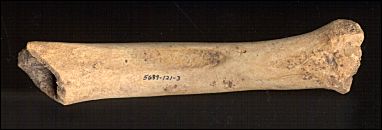December 17, 2002
Mammals/Mountain Goats
![]()
We all know that appearances can be misleading. Take as an example, the Mountain Goat. It's quite apparent that this mammal is a northern animal, reaching its southern geographic limits in the mountains of central Idaho and Washington. It would appear, then, that it and any close relatives sharing much of the same genetic material would justify the generalization that "Mountain Goats are northern creatures". As with many general statements, though, nasty contrary facts have a way of popping up.
Although Mountain Goats don't have any living close relatives, there is a fossil species, Harrington's Mountain Goat. This extinct species is now known to have occurred in the Grand Canyon area south to the Mexican Boundary in the
northern Chihuahuan Desert and thence southeast to Nuevo León. True, at its ice age occurrence at U-Bar Cave in the boot heel of New Mexico, the area wasn't desert--but then again, the climate was a long way from the
present-day conditions found in the northern highlands. All of which just goes to show that every generalization, including this one, is suspect.
![]()
Contributor: Arthur H. Harris, Laboratory for Environmental Biology, Centennial Museum, University of Texas at El Paso.
Desert Diary is a joint production of the Centennial Museum and KTEP National Public Radio at the University of Texas at El Paso.
About four/fifths of a fossil radius of Harrington's Mountain Goat recovered from U-Bar Cave, Hidalgo County, New Mexico. Scanned specimen. Museum of New Mexico specimen reposited in the Laboratory for Environmental Biology.
Jass, C. N., J. I. Mead and L. E. Logan. 2000. Harrington's Extinct Mountain Goat (Oreamnos harringtoni Stock 1936) from Muskox Cave, New Mexico. Texas Academy of Sciences, 52(2):121-132.
Mead, J. I., L. D. Agenbroad, and O. K. Davis. 1987. Extinct mountain goat (Oreamnos harringtoni) in southeastern Utah. Quaternary Research 27: 323-333.
Mead, J. I., M. K. O'Rourke, and T. M. Foppe. 1986. Dung and diet of the extinct Harrington's mountain goat (Oreamnos harringtoni). Journal of Mammalogy 67:284-293.
![]()

![]()
References
Web Resources
![]()